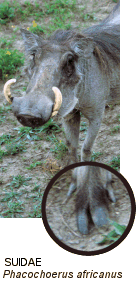 |
The pigs are a group of generalist omnivores, and lack many of the extreme
adaptations seen in other ungulates. They are medium-sized mammals (although
some individuals may weigh up to 350 kg), with relatively short legs, a compact
body, and a long, pointed head. This is an Old World family, with its eighteen
living species being found across most of Eurasia and Africa. The Suidae
appeared in the mid-Oligocene, and have survived to the present day with
only minor changes to the basic body plan. The recent genera are all relatively
recent (from the Pliocene and Pleistocene).
Swine are generally drab in coloration, with the notable exception of the brightly-colored red river hog, Potamochoerus porcus. The skin is thick, usually covered with sparse, bristly hairs, and has the most diverse assemblage of scent glands of all of the ungulates. Many species possess facial "warts", which are skin growths without a bony core. The canines are modified into ever-growing tusks which protrude from the mouth and curve upwards; they are especially large in males, serving as tools, visual status symbol, and weapon. The dental formula is variable; I 1-3/3, C 1/1, P 2-4/2-4, M 3/3 x 2 = 34-44. Most pig species are forest dwellers, although the warthogs (Phacochoerus sp.) inhabit savannahs. Forested environments have a wide range of available foods - as omnivores, pigs are able to take full advantage of this bounty, feeding on both plant and animal matter. All species have an excellent sense of smell and a cartilaginous nasal disc; both are used extensively when foraging and rooting through forest litter. The stomach has two chambers, but pigs do not ruminate. Swine are highly social: females often live in large groups (called sounders), while males tend to be solitary or monopolize a group of females as a harem. The Suidae are the only ungulates which have large litters of offspring: while litters of 2-6 are normal, some species may have up to 12 infants at a time! Infants of most species (all genera with the exception of Babyrousa, Hylochoerus, and Phacochoerus) are marked with bright horizontal stripes, which provide camouflage in forested environments. There are four tribes:
The tribes Babyrousini and Phacochoerini were formerly considered to be subfamilies, while the Potamochoerini and Suini used to be united into the subfamily Suinae; one of the primary distinctions between these three groups is their dentition. The domestication of the Eurasian wild pig Sus scrofa first occurred around 4,900 B.C. in China (although some authors date this as early as 10,000 B.C. in Thailand). While most domestic pigs today are ascribed to Sus scrofa, several domestic and feral pig populations in Indonesia appear to be descended from Sus celebensis. Pigs have also been introduced to many areas, forming feral populations in North America, New Guinea, Australia, and New Zealand (among others) - Sus scrofa is rated as one of the worst invasive species on the planet by the IUCN. |
(Synthesized from Thenius, 1981; Lucchini et al., 2005; Price et al., 2005; Wu, Pang, and Zhang, 2006; and Funk et al., 2007)
|
|
Babyrousa babyrussa
Phacochoerus aethiopicus Phacochoerus africanus Sus philippensis |
or jump to the Suidae Species List